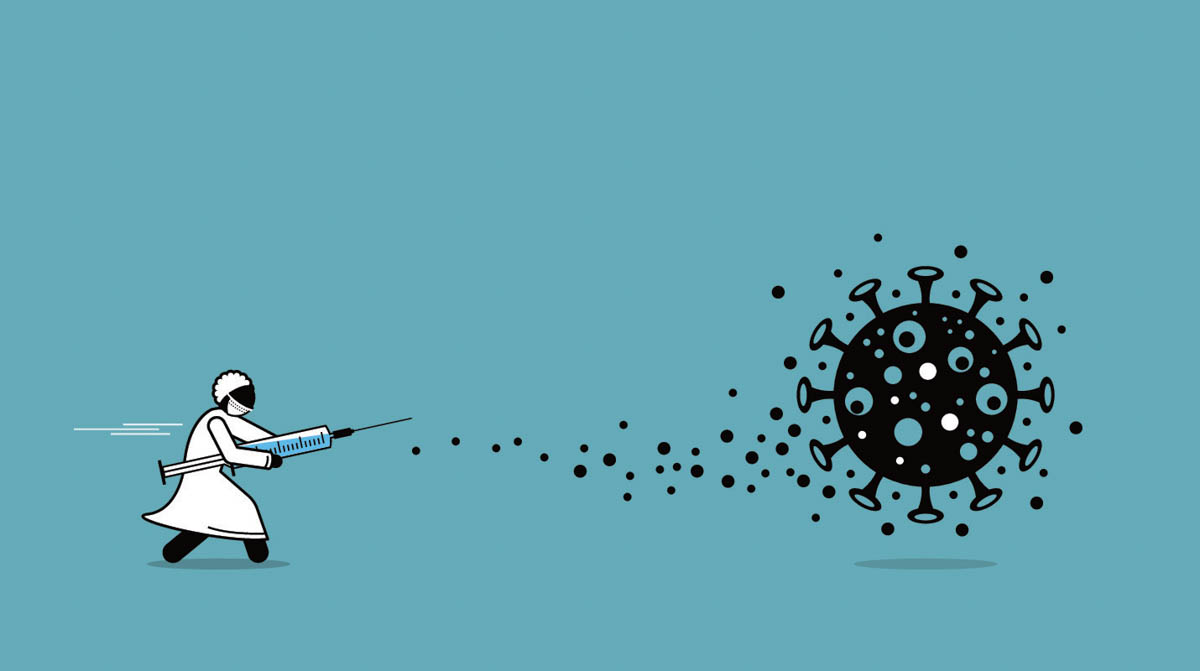 The interventionist policies to stem the COVID-19 pandemic come with a reassuring caveat: normality will resume upon the arrival of a vaccine. So, the mammoth effort of developing a COVID-19 vaccine within 18-months has begun with a caveat of its own: this has never been done before.
The interventionist policies to stem the COVID-19 pandemic come with a reassuring caveat: normality will resume upon the arrival of a vaccine. So, the mammoth effort of developing a COVID-19 vaccine within 18-months has begun with a caveat of its own: this has never been done before.
With no vaccine available, the immune system is left to defend itself against the disease and, in most cases, it can, yet at-risk cohorts are susceptible to acute and potentially fatal illness, which is why a vaccine is imperative.
A simple way to understand how vaccines work is by their composition, which consists essentially of two key factors, or molecules: the adjuvant that signals a foreign threat to a host immune system; and the antigen that induces an immune response.
The adjuvant triggers the production of antibodies, while the antigen provides the target to which the antibodies engulf and bind, curtailing the progress of the disease before infecting cells. If the disease has infected cells, the immune response will focus on creating T cells to target and destroy the infected cells.
The swift pace and quantity of pre-press and published peer reviewed articles since the outbreak have provided researchers with a great deal of knowledge about the biology of the virus and how it infects humans, providing a blueprint for the design of vaccines and inhibitors of viral entry, says Dr Roger Hajjar, Chief Medical Officer of Novoheart and Director of the Cardiovascular Research Center at Mount Sinai School of Medicine in New York.
Vaccine strategies
Although there are hundreds of vaccine programs underway, several distinct strategies have emerged, Dr Hajjar told Medical Forum.
Some are focused on the delivery of COVID-19 spike proteins to induce an immune response in humans and therefore make them resistant to the disease.
Yet, the strategies diverge when it comes to the delivery mechanisms with messenger RNA (or modified mRNA), plasmid DNA encoding and replication deficient adeno-disease encoding being trialled.
“Encoding the spike protein of COVID-19 in human subjects by direct injections will produce the capsized protein in humans inducing an immune response,” Dr Hajjar said.
With an 18-month timeline for a vaccine being widely speculated, Medical Forum, asked Dr Hajjar how realistic this was.
“Although vaccine development takes years before it is ready for the public, COVID-19 vaccine development is on track to be much faster because so many vaccine programs based on different strategies are backed by biotechnology and pharmaceutical companies which are in turn backed by governments.
“The timeline of 18 months is achievable.”
Current treatments
When acute cases of the disease began entering emergency rooms, clinicians were limited in their treatment modalities but as more cases presented so, too, did potential treatments.
As with vaccine development, pharmaceutical interventions usually go through exhaustive clinical trials, yet in this case, experimental interventions could be successful in reducing symptoms.
However, as these are experimental interventions, which are only now entering multi-phase clinical trials, it’s too soon to say what the side effects could be, Dr Hajjar said.
“There have been conflicting reports on hydroxychloroquine and chloroquine +/- azithromycin. A few small trials have shown benefit of hydroxychloroquine and chloroquine +/- azithromycin in patients who are on ventilators but other studies have not shown benefits.
“From a cardiac perspective, high doses of chloroquine was associated with adverse cardiac events and an increased mortality risk, and a higher rate of QT interval (QTc) prolongation, a lethal cardiac arrhythmogenic condition.
“More robust randomised, controlled trials of chloroquine and hydroxychloroquine for COVID-19 treatment are underway, and studies are planned or enrolling to look at chloroquine prophylaxis in health care personnel and hydroxychloroquine for post-exposure prophylaxis.”
Remdesivir, like hydroxychloroquine and chloroquine, is being used for acute cases with preliminary findings reporting potential efficacy.
According to Dr Hajjar: “Antiviral therapies are also being used with Remdesivir, an investigational nucleotide analog, being the most promising agent because of its broad-spectrum and potent activity against SARS-CoV-2 and other novel coronaviruses.
“Here, too, the results have been mixed. In a recent observational study though, Remdesivir has been shown to improve by 68% the outcome of ventilated patients with COVID-19 infections.
“Other treatments are being actively tried include tocilizumab, a monoclonal antibody against IL-6 receptor, to decrease cytokine release; lopinavir/ritonavir and ribavirin, which have limited efficiency against coronaviruses but are still being tested in infected patients; corticosteroids which could decrease inflammatory responses in the lung, but they could also lead to delays in viral clearance and increases in secondary infection risk.
“Immunoglobulin therapy is another category of treatments and constitute passive immunity as antibodies from recovered COVID-19 patients could help clear the disease.
“These therapies have been tried in small open-label trials but until randomised trials are conducted it will be difficult to evaluate their potency.”
COVID-19 and the cardiovascular system
Patients with COVID-19 and co-morbidities such as cardiovascular disease and hypertension are at a higher risk of morbidity and mortality, due to how the disease interacts with hosts, says Dr Hajjar.
“Angiotensin-converting enzyme 2 (ACE2) is the functional receptor for coronaviruses. ACE2 is a membrane-bound aminopeptidase and is involved in heart function and the development of hypertension and diabetes mellitus.
“COVID-19 infection starts by binding of the spike protein of the COVID-19 to ACE2, which is highly expressed in the heart and lungs. SARS-CoV-2 mainly invades alveolar epithelial cells, resulting in respiratory symptoms.
“These symptoms are more severe in patients with cardiovascular diseases, which might be associated with increased secretion of ACE2 in these patients compared with healthy individuals. There have been reports that COVID-19 can cause acute myocarditis and heart failure.”

